Dielectric Model of Carbon Nanofiber Reinforced Concrete
Abstract
1. Introduction
2. Tests and Results
2.1. Materials and Specimen Preparation
2.2. Test Protocol
2.3. Test Results
3. Dielectric Model
3.1. Dielectric Model Introduce
3.2. Construction of Dielectric Model
3.2.1. Concept of Model Construction
3.2.2. Determination of Dielectric Constants and Volume Rates of Each Component Phase
3.3. Modification of Dielectric Model
3.3.1. Calculation of Original Model
- (1)
- Brown model
- (2)
- CRIM model
- (3)
- Looyenga model
3.3.2. Improvement in Model Fitting
- (1)
- (2)
- (3)
3.4. Validation of Dielectric Model
4. Conclusions
- (1)
- The carbon nanofiber reinforced concrete can be considered as composed of three independent phases, matrix (mortar), coarse aggregate (limestone gravel) and air, and the dielectric models of carbon nanofiber reinforced concrete with different degrees of fiber content can be effectively established based on the Brown model, CRIM model and Looyenga model.
- (2)
- The goodness of fit between the calculated curves based on the three modified models and the measured curves was very high, and the variation rule for the dielectric constant of carbon nanofiber concrete with the frequency of electromagnetic wave can be described accurately.
- (3)
- For the ε, and ε,, as dielectric constants calculated based on the modified models, the errors relative to corresponding measured values were effectively controlled. For the dielectric constant ε,, the average error was maintained below 1.2%, and the minimum error was only 0.35%. For the dielectric constant ε,,, the average error was maintained below 3.55%.
Author Contributions
Funding
Acknowledgments
Conflicts of Interest
References
- Fukuyama, T.; Okamoto, Y.; Hasegawa, T.; Senbu, O. Capacitor model of concrete coarse aggregate by dielectric relaxation properties. Cem. Sci. Concr. Technol. 2016, 70, 193–200. [Google Scholar] [CrossRef][Green Version]
- Meng, M.; Wang, F. Theoretical analyses and experimental research on a cement concrete dielectric model. J. Mater. Civ. Eng. 2013, 25, 1959–1963. [Google Scholar] [CrossRef]
- Zhang, B.; Zhong, Y.H.; Liu, H.X.; Wang, F.M. Experimental research on dielectric constant model for asphalt concrete Material. Adv. Mater. Res. 2011, 1270, 2760–2764. [Google Scholar] [CrossRef]
- Lai, W.L.; Kou, S.C.; Tsang, W.F.; Poon, C.S. Characterization of concrete properties from dielectric properties using ground penetrating radar. Cem. Concr. Res. 2009, 39, 687–695. [Google Scholar] [CrossRef]
- Bourdi, T.; Eddine Rhazi, J.; Boone, F.; Ballivy, G. Application of Jonscher model for the characterization of the dielectric permittivity of concrete. J. Phys. D Appl. Phys. 2008, 41, 205410. [Google Scholar] [CrossRef]
- Klysz, G.; Balayssac, J.P.; Ferrières, X. Evaluation of dielectric properties of concrete by a numerical FDTD model of a GPR coupled antenna—Parametric study. NDT E Int. 2008, 41, 621–631. [Google Scholar] [CrossRef]
- Lachowicz, J.; Rucka, M. A novel heterogeneous model of concrete for numerical modelling of ground penetrating radar. Constr. Build. Mater. 2019, 227, 116703. [Google Scholar] [CrossRef]
- Siddika, A.; Mamun, M.A.A.; Ferdous, W.; Saha, A.K.; Alyousef, R. 3D-printed concrete: Applications, performance, and challenges. J. Sustain. Cem. Based Mater. 2019, 9, 127–164. [Google Scholar] [CrossRef]
- Busari, A.A.; Akinmusuru, J.O.; Dahunsi, B.I.O.; Ogbiye, A.S.; Okeniyi, J.O. Self-compacting concrete in pavement construction: Strength grouping of some selected brands of cements. Energy Procedia 2017, 119, 863–869. [Google Scholar] [CrossRef]
- Aghaeipour, A.; Madhkhan, M. Mechanical properties and durability of roller compacted concrete pavement (RCCP)—A review. Road Mater. Pavement Des. 2020, 21, 1775–1798. [Google Scholar] [CrossRef]
- Xue, J.; Briseghella, B.; Huang, F.; Nutti, C.; Tabatabi, H.; Chen, B. Review of ultra-high performance concrete and its application in bridge engineering. Constr. Build. Mater. 2020, 260, 119844. [Google Scholar] [CrossRef]
- Pan, C.; Chen, N.; He, J.; Liu, S.; Chen, K.; Wang, P.; Xu, P. Effects of corrosion inhibitor and functional components on the electrochemical and mechanical properties of concrete subject to chloride environment. Constr. Build. Mater. 2020, 260, 119724. [Google Scholar] [CrossRef]
- Liu, L.; Miramini, S.; Hajimohammadi, A. Characterising fundamental properties of foam concrete with a non-destructive technique. Nondestruct. Test. Eval. 2019, 34, 54–69. [Google Scholar] [CrossRef]
- Bouhamla, M.A.; Beroual, A. Experimental characterisation of concrete containing different kinds of dielectric inclusions through measurements of dielectric constant and electrical resistivity. Proc. Environ. Sci. 2017, 37, 647–654. [Google Scholar] [CrossRef]
- Tian, Y.P.; Huang, D.C.; Li, B. Monitoring early hydration of concrete with ground penetrating radar. Key Eng. Mater. 2017, 4348, 115–119. [Google Scholar] [CrossRef]
- Al-Mattarneh, H. Determination of chloride content in concrete using near- and far-field microwave non-destructive methods. Corros. Sci. 2016, 105, 133–140. [Google Scholar] [CrossRef]
- Hasan, M.I.; Yazdani, N. Ground penetrating radar utilization in exploring inadequate concrete covers in a new bridge deck. Case Stud. Constr. Mater. 2014, 1, 104–114. [Google Scholar] [CrossRef]
- Höhlig, B.; Schmidt, D.; Mechtcherine, V.; Hempel, S.; Schrofl, C.; Trommler, U.; Roland, U. Effects of dielectric heating of fresh concrete on its microstructure and strength in the hardened state. Constr. Build. Mater. 2015, 81, 24–34. [Google Scholar] [CrossRef]
- Sánchez-Fajardo, V.M.; Torres, M.E.; Moreno, A.J. Study of the pore structure of the lightweight concrete block with lapilli as an aggregate to predict the liquid permeability by dielectric spectroscopy. Constr. Build. Mater. 2014, 53, 225–234. [Google Scholar] [CrossRef]
- Akono, A.T. Nanostructure and fracture behavior of carbon nanofiber-reinforced cement using nanoscale depth-sensing methods. Materials 2020, 13, 3837. [Google Scholar] [CrossRef]
- Wang, T.; Xu, J.; Meng, B.; Peng, G. Experimental study on the effect of carbon nanofiber content on the durability of concrete. Constr. Build. Mater. 2020, 250, 118891. [Google Scholar] [CrossRef]
- Gawel, K.; Taghipour Khadrbeik, M.A.; Bjørge, R.; Wenner, S.; Gawel, B.; Ghaderi, A.; Cerasi, P. Effects of water content and temperature on bulk resistivity of hybrid cement/carbon nanofiber composites. Materials 2020, 13, 2884. [Google Scholar] [CrossRef] [PubMed]
- Han, J.; Wang, D.; Zhang, P. Effect of nano and micro conductive materials on conductive properties of carbon fiber reinforced concrete. Nanotechnol. Rev. 2020, 9, 445–454. [Google Scholar] [CrossRef]
- Hamidi, F.; Aslani, F. Constitutive relationships for CNF-reinforced engineered cementitious composites and CNF-reinforced lightweight engineered cementitious composites at ambient and elevated temperatures. Struct. Concr. 2020, 21, 821–842. [Google Scholar] [CrossRef]
- Wang, H.; Gao, X.; Liu, J.; Ren, M.; Lu, A. Multi-functional properties of carbon nanofiber reinforced reactive powder concrete. Constr. Build. Mater. 2018, 187, 699–707. [Google Scholar] [CrossRef]
- Wang, H.; Gao, X.; Liu, J. Coupling effect of salt freeze-thaw cycles and cyclic loading on performance degradation of carbon nanofiber mortar. Cold Reg. Ence Technol. 2018, 154, 95–102. [Google Scholar] [CrossRef]
- Yoo, D.Y.; You, I.; Youn, H.; Lee, S.J. Electrical and piezoresistive properties of cement composites with carbon nanomaterials. J. Compos. Mater. 2018, 52, 3325–3340. [Google Scholar] [CrossRef]
- Wang, H.; Gao, X.; Liu, J. Effects of salt freeze-thaw cycles and cyclic loading on the piezoresistive properties of carbon nanofibers mortar. Constr. Build. Mater. 2018, 177, 192–201. [Google Scholar] [CrossRef]
- Zhu, X.; Gao, Y.; Dai, Z.; Corr, D.J.; Shah, S.P. Effect of interfacial transition zone on the Young’s modulus of carbon nanofiber reinforced cement concrete. Cem. Concr. Res. 2018, 107, 49–63. [Google Scholar] [CrossRef]
- Galao, O.; Baeza, F.; Zornoza, E.; Garces, P. Carbon Nanofiber Cement Sensors to Detect Strain and Damage of Concrete Specimens Under Compression. Nanomaterials 2017, 7, 413. [Google Scholar] [CrossRef]
- Howser, R.N.; Dhonde, H.B.; Mo, Y.L. Self-sensing of carbon nanofiber concrete columns subjected to reversed cyclic loading. Smart Mater. Struct. 2011, 20, 085031. [Google Scholar] [CrossRef]
- Meng, M.L.; Meng, X.H. Effect of temperature and frequency on dielectric model of cement concrete. Bull. Chin. Ceram. Soc. 2015, 37, 1758–1764. [Google Scholar]
- Liu, J.L.; Xu, J.Y.; Huang, H.; Chen, H. Microwave deicing efficiency and dielectric property of road concrete modified using different wave absorbing material. Cold Reg. Sci. Technol. 2020, 174, 103064. [Google Scholar] [CrossRef]
- Liu, J.L.; Xu, J.Y.; Lu, S.; Chen, H. Investigation on dielectric properties and microwave heating efficiencies of various concrete pavements during microwave deicing. Constr. Build. Mater. 2019, 225, 55–66. [Google Scholar] [CrossRef]
- Jin, X.; Ali, M. Simple empirical formulas to estimate the dielectric constant and conductivity of concrete. Microw. Opt. Technol. Lett. 2019, 61, 386–390. [Google Scholar] [CrossRef]
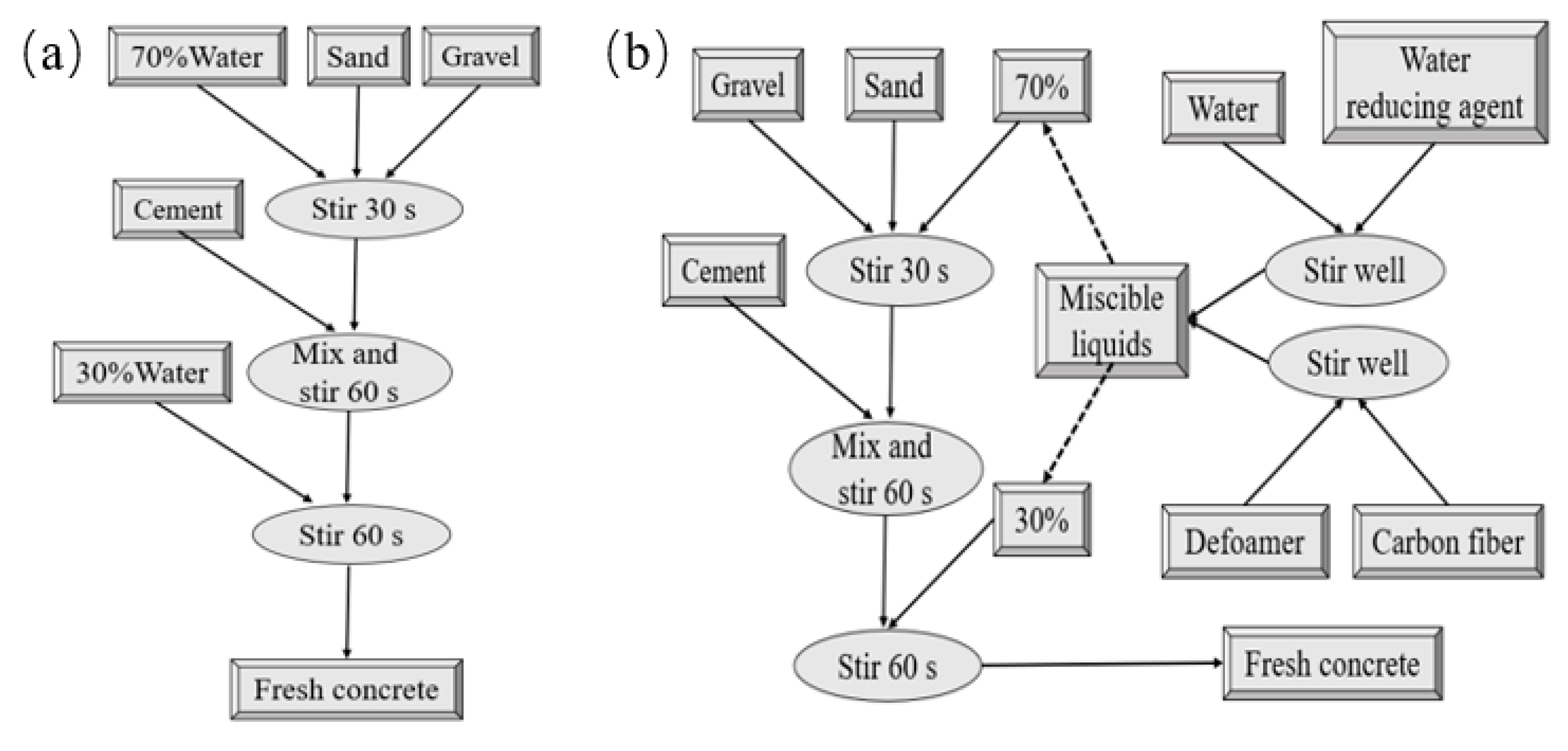


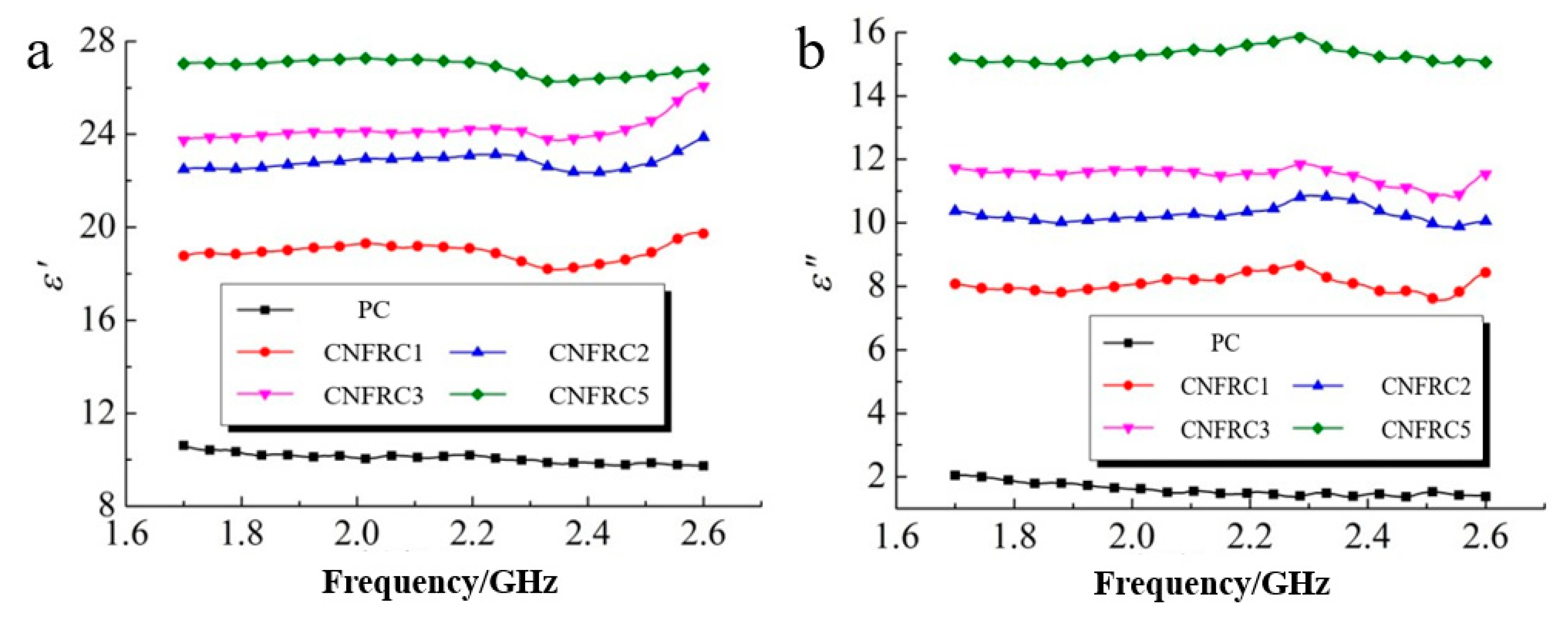
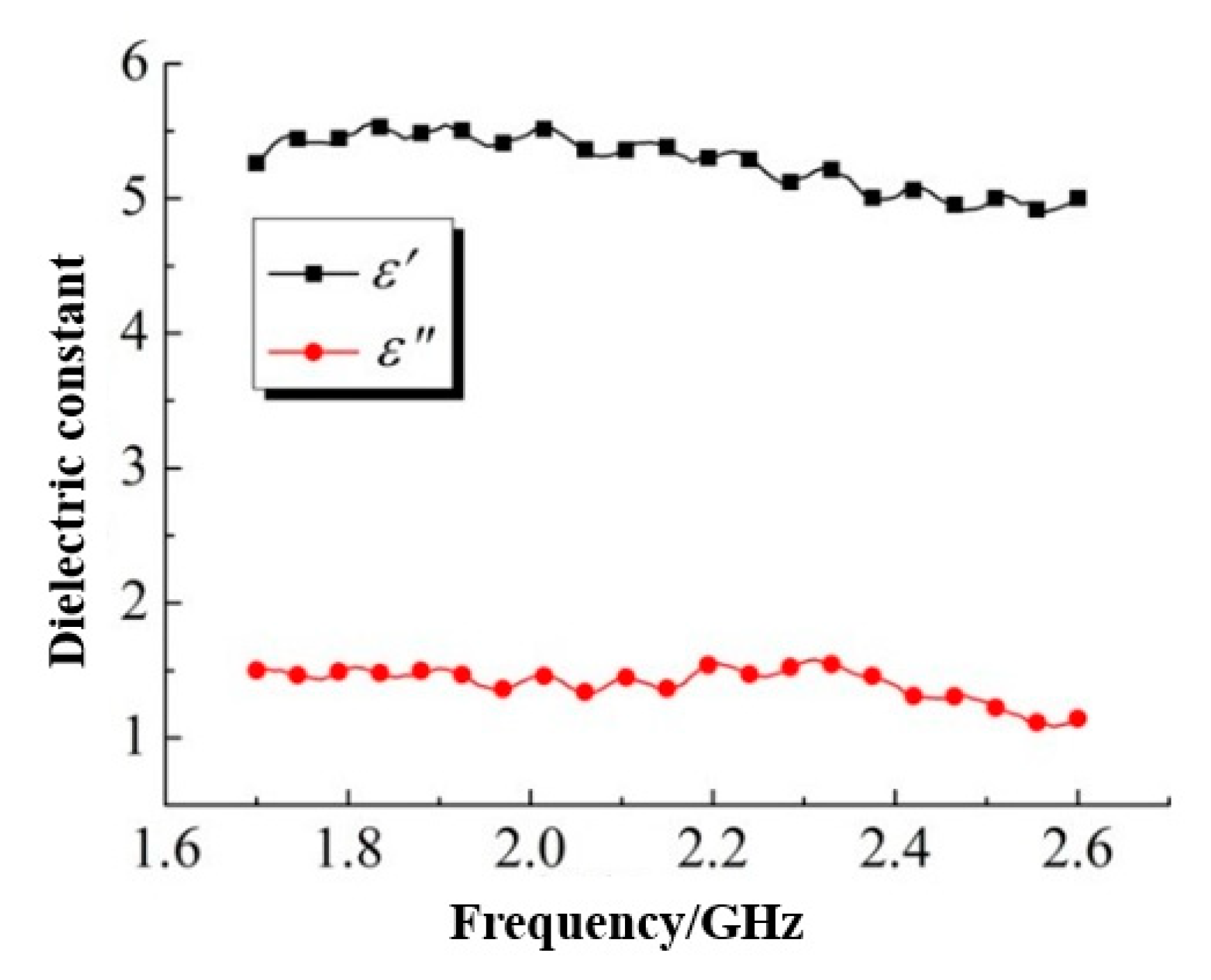
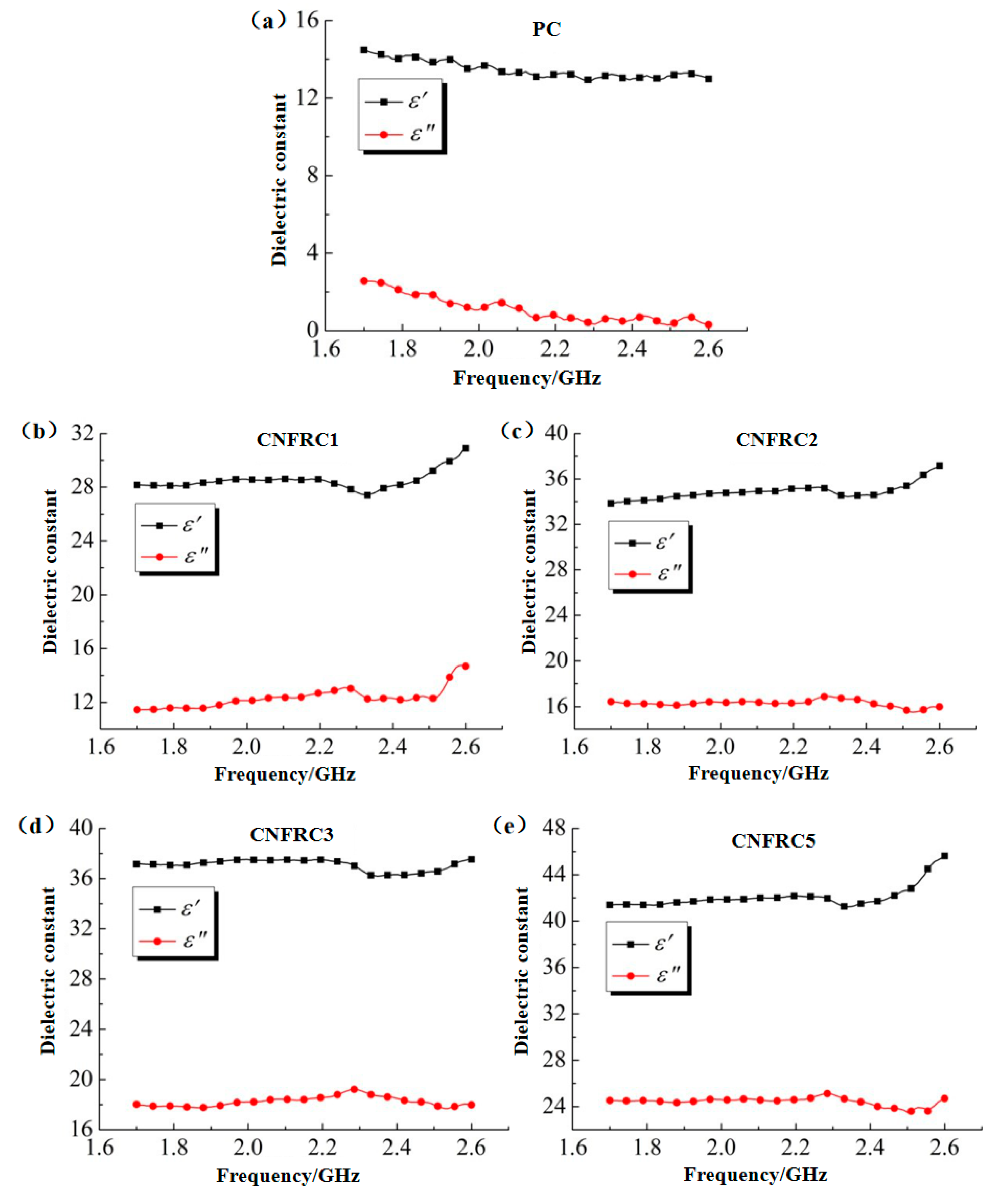
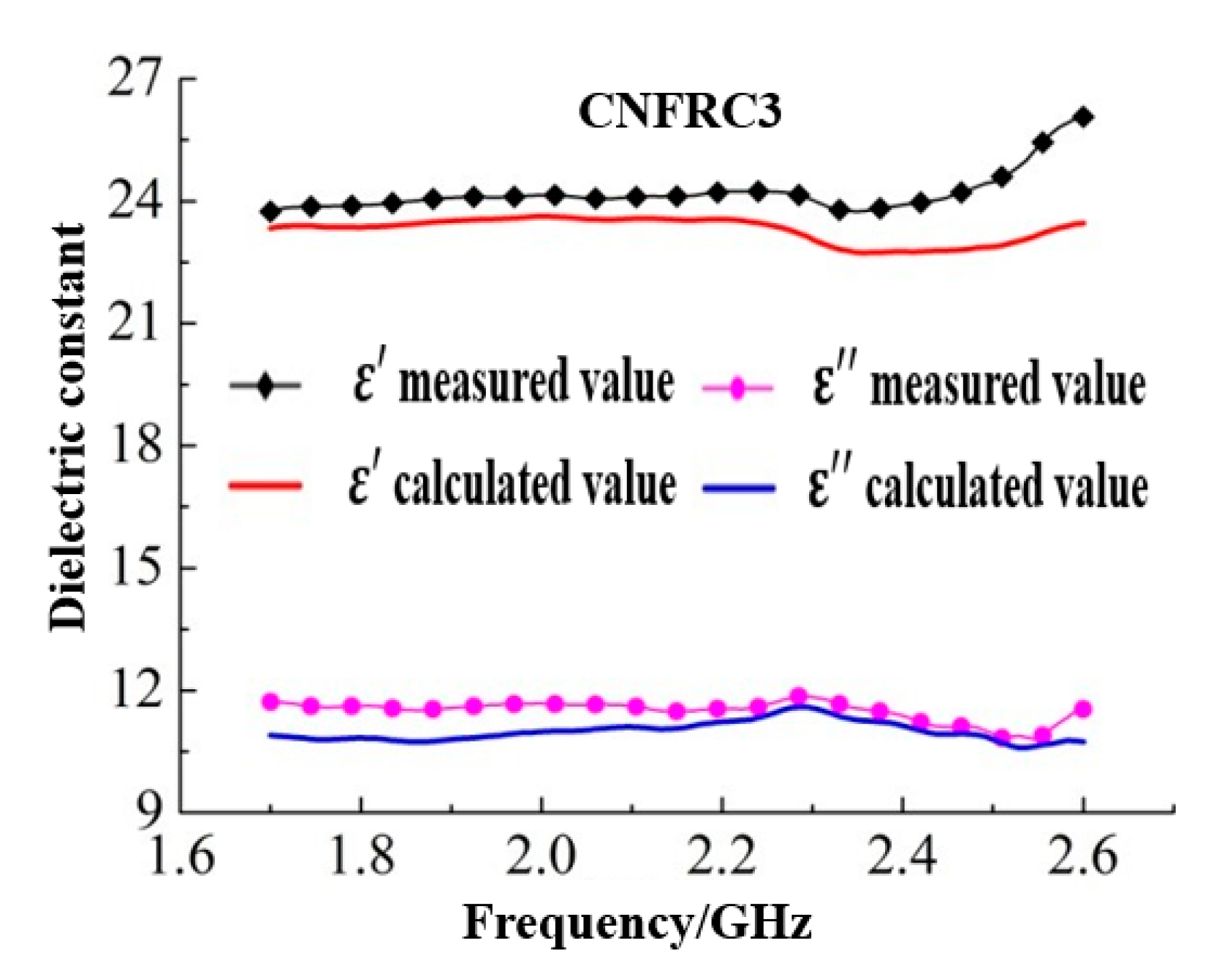
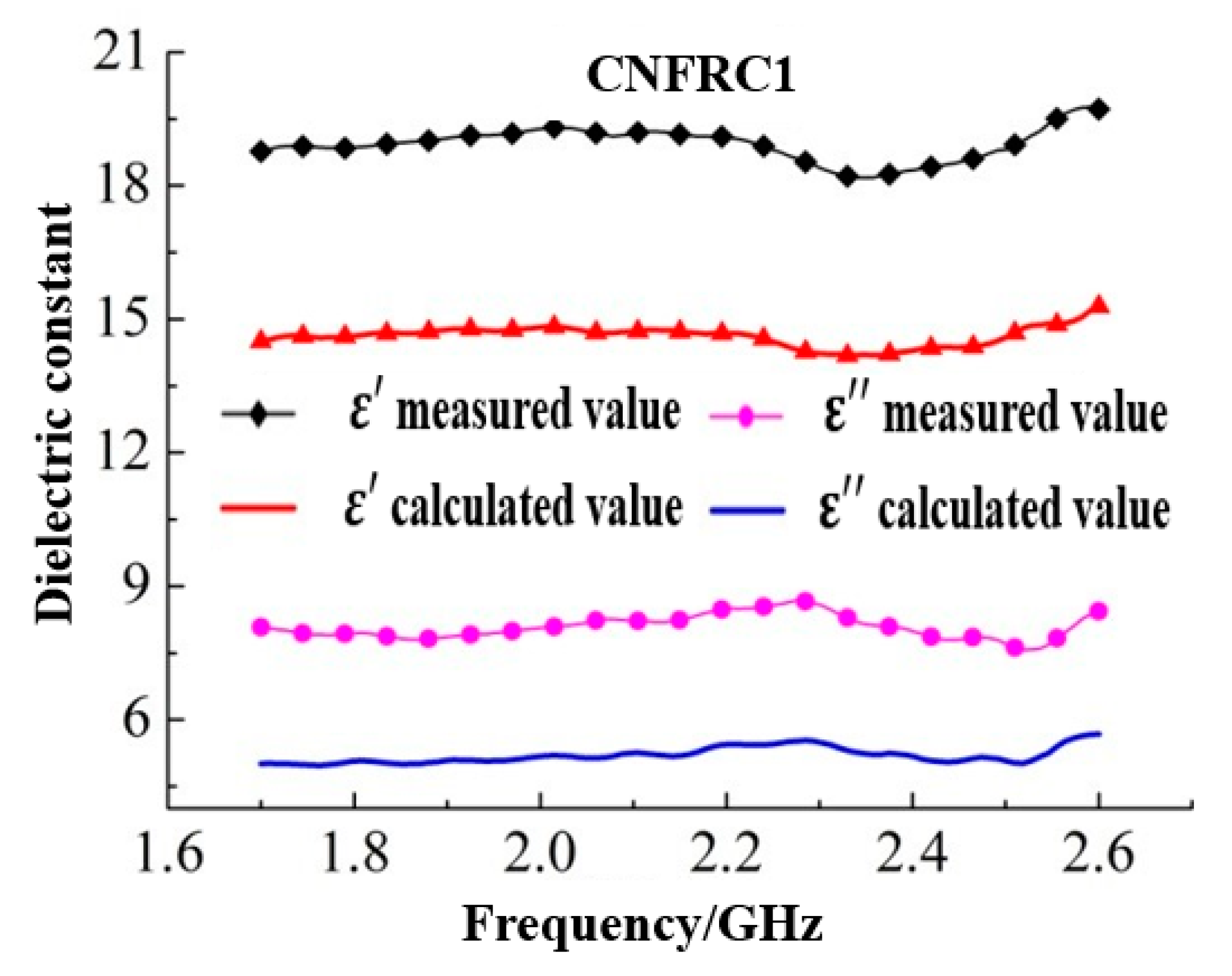
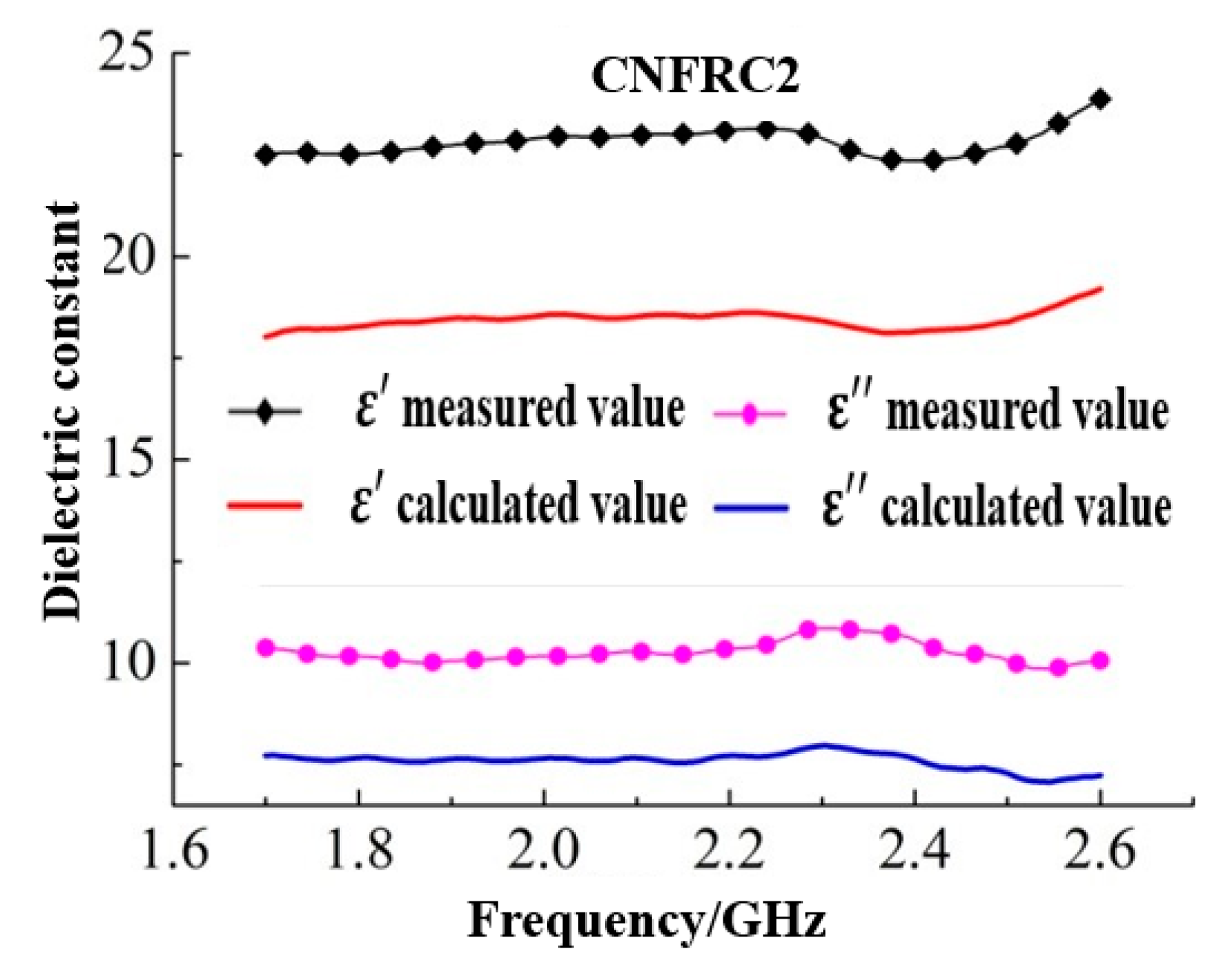

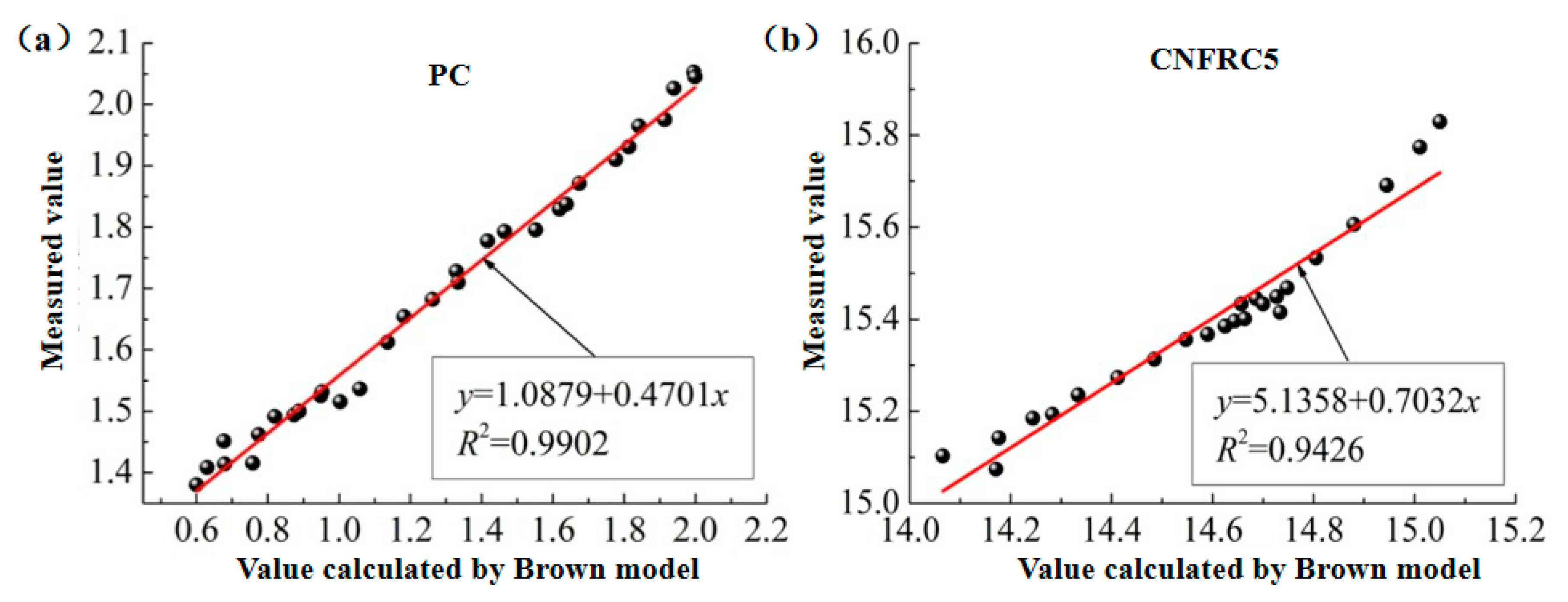

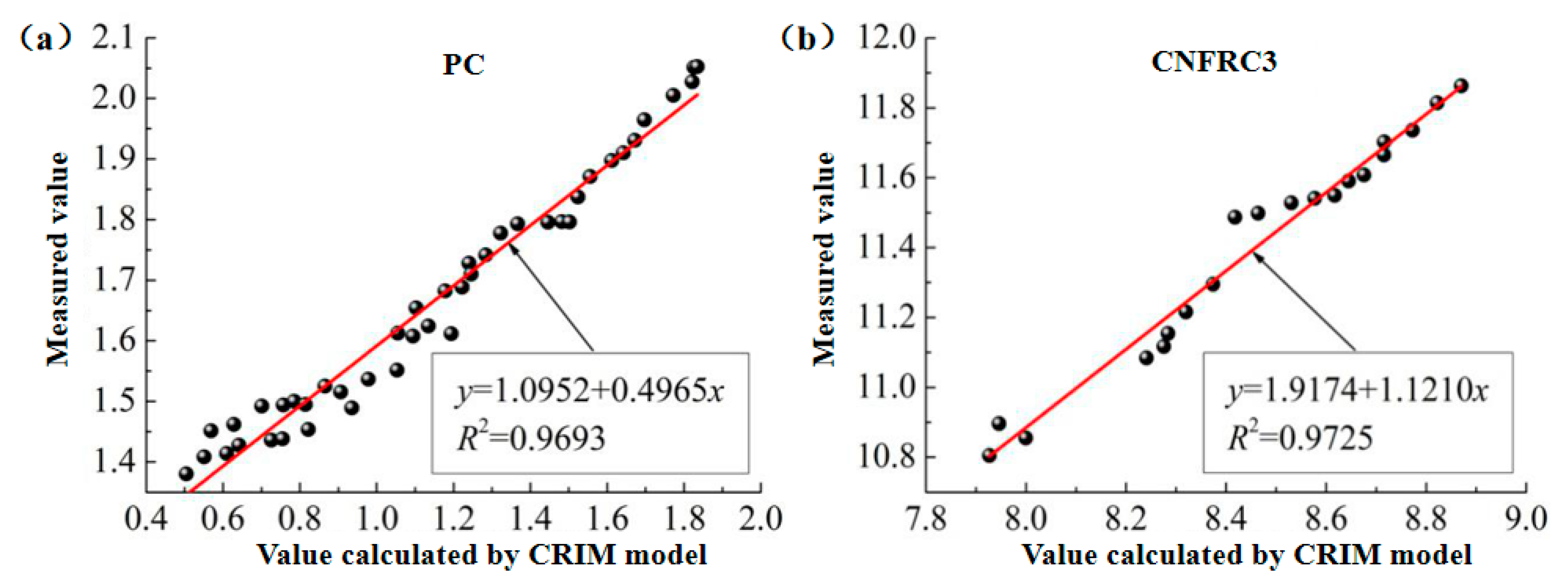
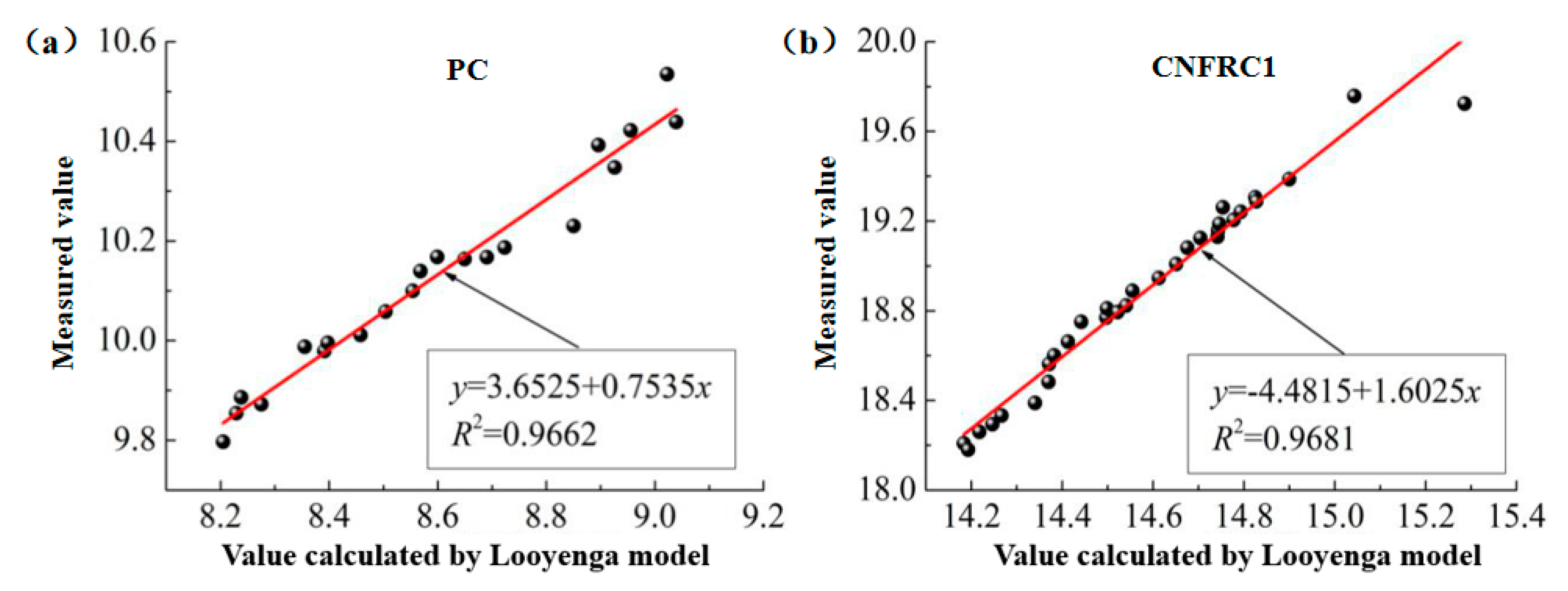
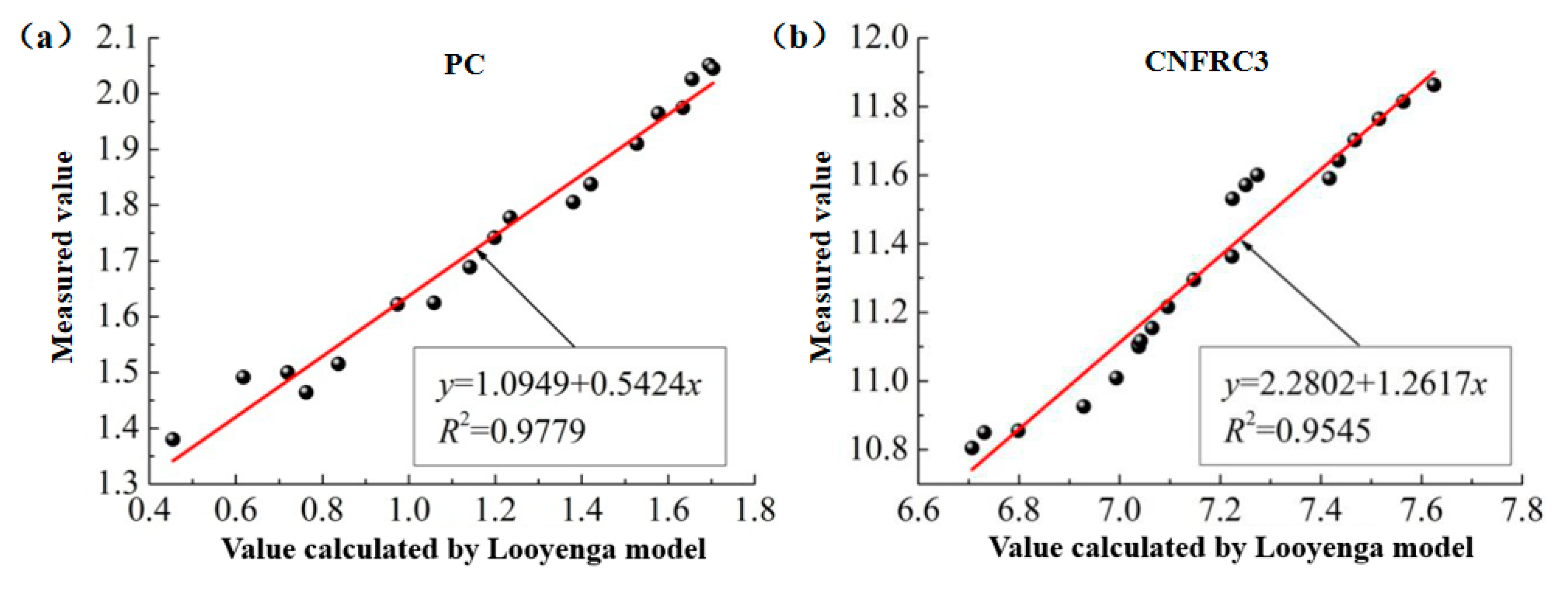

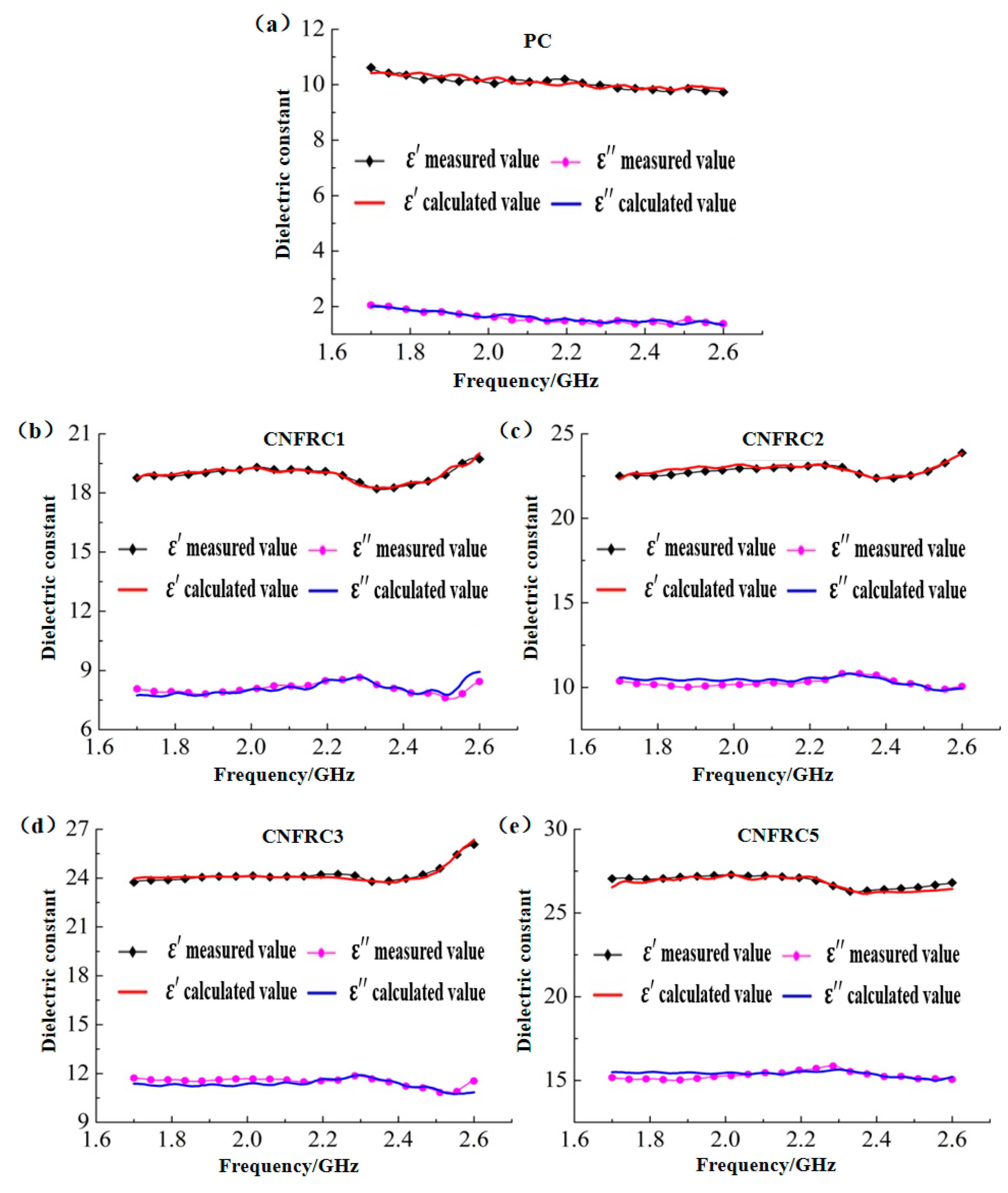

| Specimen Number | Water Cement Ratio | Carbon Nanofiber | Cement | Water | Gravel | Sand | Water Reducing Agent | Defoamer |
|---|---|---|---|---|---|---|---|---|
| PC | 0.36 | 0 | 495 | 180 | 1008 | 672 | 0 | 0 |
| CNFRC1 | 0.36 | 0.30 | 495 | 180 | 1008 | 672 | 5.0 | 0.30 |
| CNFRC2 | 0.36 | 0.45 | 495 | 180 | 1008 | 672 | 7.5 | 0.45 |
| CNFRC3 | 0.36 | 0.60 | 495 | 180 | 1008 | 672 | 10.0 | 0.60 |
| CNFRC5 | 0.36 | 0.90 | 495 | 180 | 1008 | 672 | 15.0 | 0.90 |
| Specimen Number | PC | CNFRC1 | CNFRC2 | CNFRC3 | CNFRC5 |
|---|---|---|---|---|---|
| Total pore volume/mL·g−1 | 0.0445 | 0.0403 | 0.0384 | 0.0372 | 0.0395 |
| Specimen No. | Modified Brown Model | Modified CRIM Model | Modified Looyenga Model | ||||||
|---|---|---|---|---|---|---|---|---|---|
| Ab | Bb | R2 | Ab | Bb | R2 | Ab | Bb | R2 | |
| PC | 3.8958 | 0.6512 | 0.9528 | 3.7408 | 0.7164 | 0.9148 | 3.6525 | 0.7535 | 0.9662 |
| CNFRC1 | 10.9010 | 1.6415 | 0.9391 | 6.7750 | 1.6451 | 0.9917 | 4.4815 | 1.6025 | 0.9681 |
| CNFRC2 | 1.8577 | 0.9560 | 0.9282 | 3.3751 | 1.4170 | 0.9908 | 4.8883 | 1.6272 | 0.9879 |
| CNFRC3 | 13.9716 | 0.4290 | 0.8539 | 15.9737 | 0.4135 | 0.9663 | 15.8701 | 0.4523 | 0.9179 |
| CNFRC5 | 7.8723 | 1.3218 | 0.8962 | 12.5804 | 1.8318 | 0.9582 | 10.8879 | 1.9125 | 0.9708 |
| Specimen No. | Modified Brown Model | Modified CRIM Model | Modified Looyenga Model | ||||||
|---|---|---|---|---|---|---|---|---|---|
| aB | bB | R2 | aB | bB | R2 | aB | bB | R2 | |
| PC | 1.0879 | 0.4701 | 0.9902 | 1.0952 | 0.4965 | 0.9693 | 1.0949 | 0.5424 | 0.9779 |
| CNFRC1 | 0.1481 | 1.0650 | 0.9677 | 0.2006 | 1.4027 | 0.9826 | 1.1217 | 1.7709 | 0.9377 |
| CNFRC2 | 0.3029 | 1.0773 | 0.9261 | 2.1980 | 1.0797 | 0.9692 | 2.8046 | 1.1607 | 0.9646 |
| CNFRC3 | 1.3857 | 1.1472 | 0.9550 | 1.9174 | 1.1210 | 0.9725 | 2.2802 | 1.2617 | 0.9545 |
| CNFRC5 | 5.1358 | 0.7032 | 0.9426 | 9.1860 | 0.5736 | 0.9246 | 9.5073 | 0.6436 | 0.8973 |
| Specimen No. | Brown Model | CRIM Model | Looyenga Model | ||||||
|---|---|---|---|---|---|---|---|---|---|
| Before Modification/% | After Modification/% | Improvement Effect/% | Before Modification/% | After Modification/% | Improvement Effect/% | Before Modification/% | After Modification/% | Improvement Effect/% | |
| PC | 4.95 | 1.20 | 3.75 | 11.92 | 0.96 | 10.96 | 14.64 | 1.04 | 13.6 |
| CNFRC1 | 3.68 | 0.91 | 2.77 | 17.51 | 0.43 | 17.08 | 22.78 | 0.38 | 22.4 |
| CNFRC2 | 3.57 | 0.49 | 3.08 | 19.17 | 0.35 | 18.82 | 25.13 | 0.49 | 24.64 |
| CNFRC3 | 3.66 | 0.46 | 3.2 | 19.79 | 0.53 | 19.26 | 25.97 | 0.39 | 25.58 |
| CNFRC5 | 2.93 | 1.05 | 1.88 | 19.67 | 0.56 | 19.11 | 26.36 | 0.53 | 25.83 |
| Specimen No. | Brown Model | CRIM Model | Looyenga Model | ||||||
|---|---|---|---|---|---|---|---|---|---|
| Before Modification/% | After Modification/% | Improvement Effect/% | Before Modification/% | After Modification/% | Improvement Effect/% | Before Modification/% | After Modification/% | Improvement Effect/% | |
| PC | 29.85 | 3.47 | 26.38 | 36.15 | 3.34 | 32.81 | 40.89 | 3.55 | 37.34 |
| CNFRC1 | 7.54 | 2.50 | 5.04 | 26.31 | 1.79 | 24.52 | 35.66 | 1.61 | 34.05 |
| CNFRC2 | 3.96 | 1.29 | 2.67 | 26.04 | 1.69 | 24.35 | 36.22 | 1.84 | 34.38 |
| CNFRC3 | 4.30 | 2.44 | 1.86 | 27.13 | 1.87 | 25.26 | 37.56 | 1.75 | 35.81 |
| CNFRC5 | 4.45 | 1.15 | 3.3 | 29.09 | 1.12 | 27.97 | 40.16 | 1.11 | 39.05 |
Publisher’s Note: MDPI stays neutral with regard to jurisdictional claims in published maps and institutional affiliations. |
© 2020 by the authors. Licensee MDPI, Basel, Switzerland. This article is an open access article distributed under the terms and conditions of the Creative Commons Attribution (CC BY) license (http://creativecommons.org/licenses/by/4.0/).
Share and Cite
Wang, Z.-H.; Xu, J.-Y.; Bai, E.-L.; Nie, L.-X. Dielectric Model of Carbon Nanofiber Reinforced Concrete. Materials 2020, 13, 4869. https://doi.org/10.3390/ma13214869
Wang Z-H, Xu J-Y, Bai E-L, Nie L-X. Dielectric Model of Carbon Nanofiber Reinforced Concrete. Materials. 2020; 13(21):4869. https://doi.org/10.3390/ma13214869
Chicago/Turabian StyleWang, Zhi-Hang, Jin-Yu Xu, Er-Lei Bai, and Liang-Xue Nie. 2020. "Dielectric Model of Carbon Nanofiber Reinforced Concrete" Materials 13, no. 21: 4869. https://doi.org/10.3390/ma13214869
APA StyleWang, Z.-H., Xu, J.-Y., Bai, E.-L., & Nie, L.-X. (2020). Dielectric Model of Carbon Nanofiber Reinforced Concrete. Materials, 13(21), 4869. https://doi.org/10.3390/ma13214869





